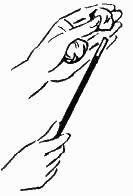Lesson 4 (2)
This time hold ball from RIGHT hand and torn pieces as one in LEFT hand as in preceding effect, but remember to keep ball which you have palmed in left hand concealed from audience. Then palm off the torn pieces in right hand and reach for pencil, dropping torn napkin into hat as before.
Bring up pencil and point at the balls in left hand. The audience thinks ball between the first two fingers and thumb is the, torn napkin. Your torn pieces, however, have been disposed of. Your trick from now on is easy to do and there is nothing to detect. The audience, however, thinks the main part is yet to come.
"Using a pencil with this trick is all bunk, but it looks professional. I could have waved my handkerchief with just as much power. However in reaching for my pencil, I did something. It was to exchange the whole napkin in my palm for the torn pieces at the ends of my fingers."
As you say this slip one ball above the other by rolling the ball in back over the front one with the thumb and fingers. You may put wand under arm and show how exchange is made by using both hands.
"The single hand move shows how you do it with one hand while reaching for pencil."
"Then all I have to do is to tap the ball which is now the whole napkin, the torn pieces being in my palm, unroll the ball..."

Place pencil under right arm and unroll ball.
"And show that the napkin has been fully restored. Then you can bow as you have successfully performed the experiment." Drop napkin on table.
"Now, the torn pieces in the left hand you can get rid of in any way that you desire. Of course, if the audience is watching you too closely, then the best way I have
found is to take the torn pieces and blow gently thereon twice and pronounce the words, 'Chow Mein Chop Suey.' Surprising as it might seem, if you slowly unroll the ball of pieces..." Unroll the ball.
"You will find that they have all joined themselves together, making a complete napkin as in the beginning. Then your audience will never know what became of the torn pieces. Don't tell them."
As a rule, it is never safe to EXPOSE a method. The less an audience knows about your method of working, the better. But in a case of this kind where you apparently expose and yet do not. you have led your audience to think that perhaps palming and using two pieces of paper is all wrong.
SUGGESTIONS:
If you prefer, you may have two napkins rolled into balls and placed in right coat pocket, together with the two napkins which should be folded. You will find that you have no difficulty when reaching into pocket for napkin to bring out a ball concealed in palm of right hand. This method is very handy when you have to work without preparation or are so situated that you cannot arrange napkins on table without being detected.
You may also dispense with hat and pencil and use a pocket knife instead, which you can have in right trousers' pocket. In reaching for pocket knife, leave ball of torn pieces behind in pocket. You will find that this way of working makes the effect entirely impromptu.
This is a good banquet trick where paper napkins are used. During the course of the banquet, get two extra napkins. Roll them into balls and place in right coat pocket. Get knife into right trousers' pocket. Instead of a knife, a half dollar can be used. If half dollar is used, you can explain "the power of money." Merely touch ball with money. "Cross your palm with fifty cents," as the gypsy fortune teller would say.
When you start to perform, simply reach over and pick up a paper napkin from the table.
TARBELL SYSTEM, INCORPORATED, Chicago.
LESSON 5
In your next lesson I give you three more interesting tricks with tissue paper, based on different principles.
1--A long strip of paper is torn into a number of pieces. placed in a saucer and burned to ashes. Performer shows both hands empty; then he picks up a bit of the ashes, rubs them a little, and they change to the original strip of paper again.
2--Two squares of tissue about 14 inches across are shown. One is black and the other is green. Performer tears them into a number of pieces, blows on them, and they are seen to have changed into a fancy French paper hat for milady.
3--Three bowls are shown empty. In front of each are placed three tissue paper balls -- red, white, and blue, respectively. In one bowl the three red balls are dropped one at a time, in the second bowl the three white balls are placed, while in the third bowl the three blue balls are dropped one at a time. Attention is called to the patriotic nature of the colors and to the fact that they do not remain apart very long. The bowls are turned over and instead of each containing three balls of the same color, each bowl holds a red, white, and blue ball of paper.
Bạn đang đọc truyện trên: truyentop.pro